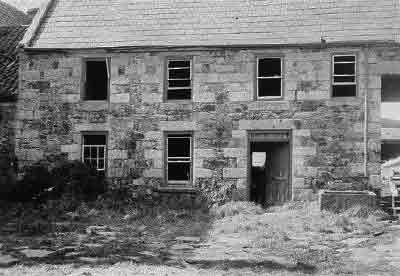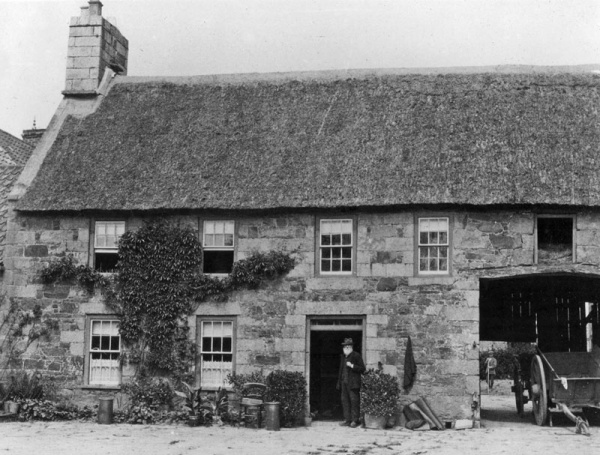Historic Jersey buildings
If you own this property, have ancestors who lived here, or can provide any further information and photographs, please contact us through editorial@jerripedia.org |
Property name
Le Geyt Farm
Other names
La Croix de Bois
Location
Grande Route de St Martin
Type of property
Prior to demolition, there were two traditional Jersey farmhouses, one dating from the early 18th century, and the other from the late 18th century. An outhouse or tackle/harness house lay behind the houses, parallel to the older building.
Families associated with the property
- Le Geyt: Abraham Le Geyt, second son of Abraham Le Geyt and Rachel Benest, of La Guillaumerie, Maufant, settled at La Croix de Bois, later anglicised to Five Oaks, in the Vingtaine of Pigneaux. His first wife, whom he married at St Saviour in 1716 was Elizabeth Ahier of La Ville Patier, in the same parish. He and Elizabeth, his wife, lived here from 1716.
Other Le Geyts of interest in that they had served the parish, who lived here, included Abraham Le Geyt (1743-1806), Vingtenier of Pigneaux, described in a Laurel Party newspaper as un grand patriot, for his ardent support of the Island's conservative Laurel Party, and its Lempriere leaders; his son, Abraham (1766-1847), who was from 1805 Vingtenier of Pigneaux, and Abraham Le Geyt (1790-1856), who was an Ensign in the Militia, a Constable`s Officer 1819-1820, and Vingtenier of Pigneaux from 1830.
The line ended with the decision of Abraham Josué Le Geyt (1851-1874) to emigrate to Auckland, New Zealand. He sold his farm and land in 1873 to his mother, Jeanne Fauvel, and sailed with his young wife, Eliza Ann, nee Champion, and their two-year-old son, aboard the Cospatrick for Auckland. Fire broke out aboard ship when they were off the coast of what is now Namibia. The ship eventually foundered. There were hardly any survivors among the hundreds of would-be emigrants.
Datestones
- ALG EAH 1716, for Abraham Le Geyt and Elizabeth Ahier, who married in that year. [1]
- ALG AAL 1773, for Abraham Le Geyt and Anne Alexandre, who married in St Helier on 9 May 1742 [2]
- ALG IEN 1832, for Abraham Le Geyt and Jeanne Esnouf, who married in St Helier on 4 December 1819. On the south facade of the newer house.
Former lay-out of the buildings
The two houses on the site comprised the older of the two farmhouses (see photographs, one of which was taken in the early stages of demolition) and the newer south-facing house that will have replaced the former as the main house in the late-18th century. A chimney and part of the tiled roof of this building can be seen to the left, behind the old farm, in both pictures. It was a fine example of a late 18th century house, with five bays on the first floor and four bays, two on each side of the front door, on the ground-floor. The house had a decorative ashlar frontage. Standing in the garden, facing the front of the house, one saw on the right, a conservatory forming the corner between the garden wall and the house. In front of this, against the same wall, which separated the garden from the main road, was a fig tree. Behind the two houses, was a cobbled yard consisting of sea-worn former beach cobbles. When standing with one`s back to the newer house, outside the back door, the left side of the yard was bordered by the outhouse used as a tackle/harness house. Located on this building, a little to the left of the man holding a hoe, in the far background, was the 1716 engraved stone.
Court Records, in the form of partages and 19th century censuses, show the farmland consisted of 38 vergées. The property was sold by the last of its Le Geyt owners in 1873. It was subsequently farmed by Mr Philippe Le Templier and then by an English family named Blake. After the Second World War, the farmland was sold away from the farm, to J W Huelin and Company, whose premises were increased to include part of this former Le Geyt land, which lay to the south of Le Geyt Farm, as it had come to be called.
The house and farm buildings were sold to Jersey Dairies. When the author of these notes [3] visited the property in 1970 the buildings stood empty but in good condition, only to be demolished by the purchasers, without any trace left of any of the buildings, not long afterwards. As Joan Stevens wrote: "It is a sad reflection on current [1977 and to this day] economic affairs that it paid better to demolish the whole structure rather than to make use of it". [4]
The utilitarian Le Geyt Centre replaced the above, and most of the stone from the buildings was sold as hardcore for the Jersey Evening Post car park. It is interesting to note that the Le Geyt Centre has already become "not fit for purpose". Had it been established within the framework of the previous buildings that were on the site, one wonders whether it would have needed replacement.
Old Jersey Houses
A brief entry in Volume Two, after the house had been demolished, referred only to two of the datestones.
Notes and references
- ↑ This stone was missed by Joan Stevens, in her list of dated and initialled stones, which included others on the property, in Volume Two of Old Jersey Houses
- ↑ The initials and date can be seen on the above pictures, if magnified, of the old farm house
- ↑ Guy Dixon
- ↑ Stevens was mistaken as to which house had the 1773 datestone. She also wrote that the Leggetts of Ontario were descended from this branch of the Le Geyt family. In fact, they were descended from Jean Le Geyt of Maufant.

